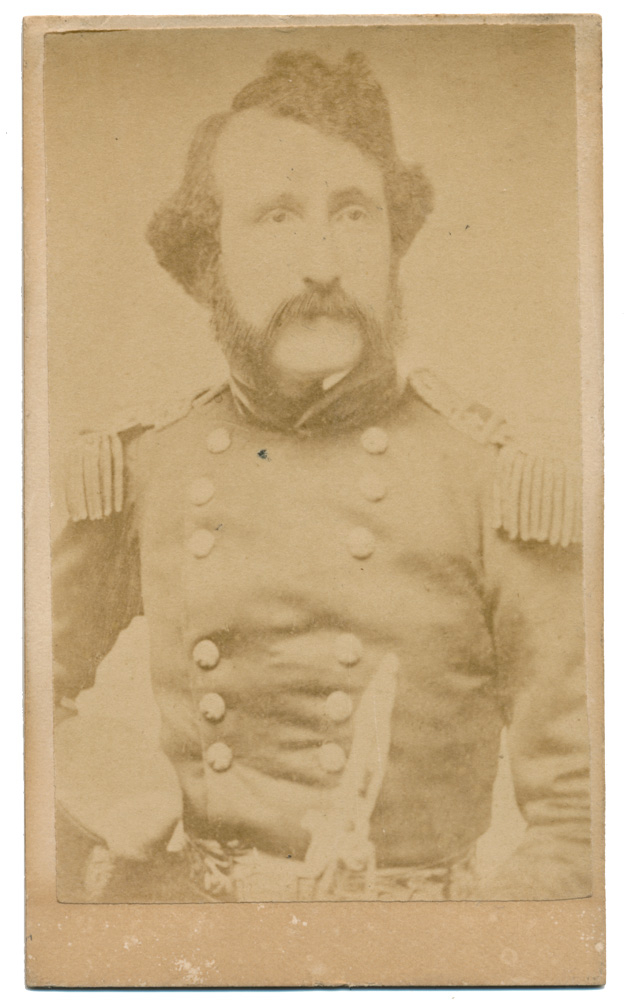site search
online catalog
LATE WAR CDV OF GENERAL WILLIAM TALIAFERRO OF VIRGINIA

Hover to zoom


$375.00 SOLD
Quantity Available: None
Item Code: 1138-518
Image is a close-up waist-up view of Taliaferro in a dark double-breasted frockcoat with brush epaulettes and high collar. Just visible at the bottom of the image is the hilt of his sword and his heavily decorated belt but the belt plate cannot be seen.
Clarity is good but the contrast is a bit light. Paper is good but the bottom of the mount is toned some.
Reverse has a decidedly late-war or even early post-war photographer’s imprint for LEE GALLERY… RICHMOND, VA.
Image is from the collection of the late William A. Turner.
William Booth Taliaferro was born at Belleville, Gloucester County, Va., December 28, 1822. He was educated at Harvard College and William and Mary, being graduated at the latter institution in 1841.
His activity was directed to a military channel by the Mexican War, and on April 9, 1847, he became captain of a company of the Eleventh United States infantry. He was promoted major August 12th, and held this rank during the following year, his command being disbanded August, 1848.
He then returned to the pursuits of civil life, and was one of the Democratic presidential electors in 1856, but continued to be prominent in military affairs and commanded the State forces at the time of John Brown's raid.
As major-general of Virginia militia, he took command at Norfolk on April 18, 1861, and later with the rank of colonel was assigned to the post at Gloucester Point, opposite Yorktown. Subsequently he marched with the Twenty-third Virginia regiment to reinforce General Garnett in West Virginia.
During the retreat from Laurel Hill, Colonel Taliaferro was in command of the rear guard which gallantly contested the enemy's pursuit at Carrick's Ford, just before Garnett was killed. At the battle on Greenbrier River, October 3rd, he commanded a brigade, consisting of his own regiment, the Twenty-fifth and Forty-fourth Virginia regiments, and contributed largely to the victory by his cool and gallant conduct.
On March 4, 1862, he was promoted brigadier-general. He joined Jackson in the Valley early in December, and with a brigade composed of the Tenth, Twenty-third and Thirty-seventh Virginia, took a prominent part in the defeat of the Federals at McDowell, where he was in immediate command on the field after Edward Johnson was wounded, and participated in the victories at Cross Keys and Port Republic.
Continuing in command of Jackson's Third brigade, he fought at Cedar Mountain, August 9th, and after the death of General Winder was given charge of Jackson's division. In this command he continued during the subsequent operations about Manassas, participated in the maneuvers around Pope's army, and on August 28th, when Jackson determined to strike the enemy as he moved along the Warrenton Pike, he immediately ordered Taliaferro to take his division and attack.
In the fierce fight which followed, sustained on the Confederate side by Taliaferro and Ewell, both those commanders were seriously wounded. He was able to return to the field in time to participate in the battle of Fredericksburg, where he rendered efficient service in repelling the Federal force which secured temporary lodgment in the Confederate lines.
His subsequent military career was in the department of South Carolina, Georgia and Florida, to which he was assigned in March, 1863, as commander of the district of Savannah. During the famous assault on Battery Wagner, July, 1863, he had charge of the defenses and troops on Morris Island, and next month he took command of a division on James Island.
February 20, 1864, he was given temporary command of all troops in the district of East Florida, which embraced the forces engaged at Olustee. Returning March 5th to James Island, in May he was assigned to the Seventh district of South Carolina, and the entire State was put under his military charge in December of that year.
When Sherman's army reached Savannah, he exercised command to the north of that city, with the forces of Jenkins, Harrison and Chestnut, at Coosawhatchie and Pocotaligo, guarding the route of escape for Hardee. In the latter part of December, he was given command of a division made up of Elliott's, Rhett's and Anderson's brigades, with which he participated in the subsequent movements, being promoted on January 1, 1865, to the rank of major-general.
After the surrender of Johnston's army, he returned to Gloucester, Va., where he completed his long career of honor and usefulness. He served ten years in the State legislature, and rendered good service in the cause of education as a member of the board of visitors of the Virginia Military Institute, William and Mary college and other State institutions.
His death occurred at his home in Gloucester County, February 27, 1898. He is buried in Gloucester County’s Ware Episcopal Church Cemetery. [ad] [ph:L]
~~~~~~~~~~~~~~~~~~~~~~~~~~~~~~~~~~~
THIS ITEM, AS WITH ALL OTHER ITEMS AVAILABLE ON OUR WEB SITE,
MAY BE PURCHASED THROUGH OUR LAYAWAY PROGRAM.
CLICK HERE FOR OUR POLICIES AND TERMS.
THANK YOU!
Inquire About LATE WAR CDV OF GENERAL WILLIAM TALIAFERRO OF VIRGINIA
Most Popular
Historical Firearms Stolen From The National Civil War Museum In Harrisburg, Pa »
Theft From Gravesite Of Gen. John Reynolds »
Selection Of Unframed Prints By Don Troiani »
Fine Condition Brass Infantry Bugle Insignia »
Large English Bowie Knife With Sheath 1870’S – 1880’S »
Imported (Clauberg) Us Model 1860 Light Cavalry Officer's Saber »
featured item
SILVERED PRESENTATION FIFE TO MARTIN MURPHY, 4th NEW YORK VOLUNTEERS, 17th NY VETERAN ZOUAVES, AND REGULAR ARMY
This elegant silvered fife, 15-1/4” long, bears a great presentation and was carried by a company musician with Civil War service in two New York regiments, one of them a zouave regiment, and substantial service in the regular army. He seems to… (1268-167). Learn More »


